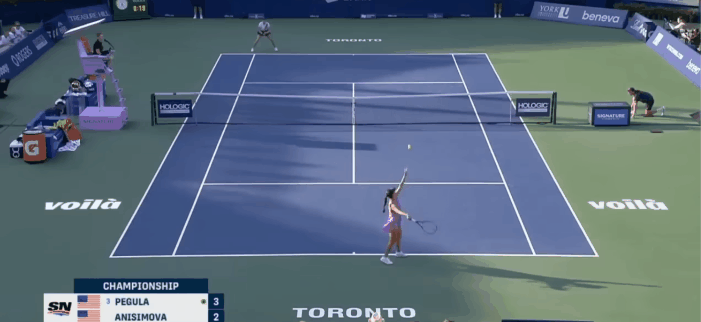Pegula goes back-to-back in Toronto
A first set clinic, consistency reigns supreme, Anisimova’s raw power, National Bank Open dominance
Pegula d. Anisimova 6-3, 2-6, 6-1
Jessica Pegula successfully defended her National Bank Open title on Monday evening in Toronto, defeating a resurgent Amanda Anisimova in a seesawing 3-set battle.
It was an intriguing tactical battle – for what Pegula lacks in raw power against Anisimova, she makes up for in consistency and precision. It was this ability to keep errors to a minimum, while capitalising on her early serving dominance, that were big factors in Pegula’s win, while Anisimova’s hard-hitting groundstrokes failed to fire in the big moments.
A first set clinic from Pegula
Pegula started with a bang in the first set against Anisimova on Monday. She immediately broke the Anisimova serve in the first game of the match, before proceeding to win an impressive 16 of 17 service points, and all 12 of her first serve points over the course of the set.
Although Pegula doesn’t have the tour’s biggest serve, hovering somewhere around an average first-serve speed of 160km/h (100mph), she used two serves particularly well against Anisimova: the serve down the T, and body serves to the Anisimova forehand.
Out of the 6 aces that Pegula served, 5 came down the T (4 on the deuce side), winning her valuable free points in the first set.
The body serve was also used to good effect against Anisimova, which often handcuffed Anisimova on the forehand wing, resulting in some UF errors and free points.


Pegula puts Anisimova serve under pressure
Except for some parts of the second set, Pegula was able to place pressure on the Anisimova serve – particularly the second serve – due to occasionally aggressive return positioning and hitting deep returns, particularly from the forehand wing.
Take a look at two different examples below. In the first example, Pegula steps inside the baseline and directs the return deep and to the feet of Anisimova, resulting in an Anisimova backhand error:
In this second example, Pegula is just behind the baseline, but reads the Anisimova serve out wide, and is consequently able to get her racquet around the ball with ample time and hit an angled crosscourt winner, again from the forehand wing:
Anisimova’s raw power
It’s well known that Anisimova generates significant power from both her forehand and backhand wings. She tends to hit flatter, faster balls that can push opponents around the court – either inducing errors from her opponents or hitting outright winners.
Over the course of the match, we saw both the good and the bad of Anisimova’s powerful hitting. When it comes off (like in the second set), both wings are immensely damaging and allow her to dictate rallies.
Take a look at this example, at 2-1, 30-15 in the second set. Anisimova hits an angled backhand from the middle of the court, putting Pegula immediately on the back foot and resulting in a short ball, which Anisimova quickly moves to, hitting a booming forehand down the line. Pure power and ball striking – so hard to stop:
Another example of Anisimova’s ability to generate serious power can be seen in the following point at 3-1, 30-40 in the first set. Anisimova sets up a +1 backhand off the first serve and drills it down the line. Pegula has no chance:
Following on from the example immediately above, Anisimova didn’t generate enough +1 opportunities off her serves today. She only won 57% of rallies of 1-3 shots in length on her own serve, compared to Pegula’s 78%.
The bottom line: Pegula’s consistency reigns supreme
The consistency of Pegula’s groundstrokes contrasted against the often-errant groundstrokes of Anisimova were a big factor in the match today.
Anisimova hit a lot more unforced errors – 31 to be exact (compared to 11 for Pegula), but this can sometimes be manageable if she is hitting enough winners to compensate. After all, Anisimova does play quite aggressively. However, Anisimova only hit one more winner than Pegula today – she wasn’t quite able to blast through the Pegula defence as well as she might have hoped.
One last example to reinforce the value of Pegula’s consistency – a longer rally, where Anisimova has the initiative after a big forehand that hits the line, but Pegula stays alive, waits for a (somewhat) shorter ball, and hits a lovely winner on the stretch:
Conclusion
A topsy-turvy and entertaining match. Pegula was clearly on top during the first and last sets – enjoying good success off her own serve and remaining rock solid in rallies, while Anisimova showed glimpses of her damaging power.
Pegula is continuing her rich vein of form in Cincinnati and is shaping up as a solid U.S. Open contender. My only concern is that I’m not sure she has a big enough weapon, an ‘x-factor’ per se, that could help her get over the line deep into a Grand Slam. Only time will tell.
As an aside, it’s great to see Anisimova back and playing great tennis after a tough couple of years in her personal life. Wishing her all the best.
I had every intention to write up Popyrin’s come-from-the-clouds win at Montreal, but I don’t think time will permit. I’ll have some content up for Cincinnati. Thanks for reading.










